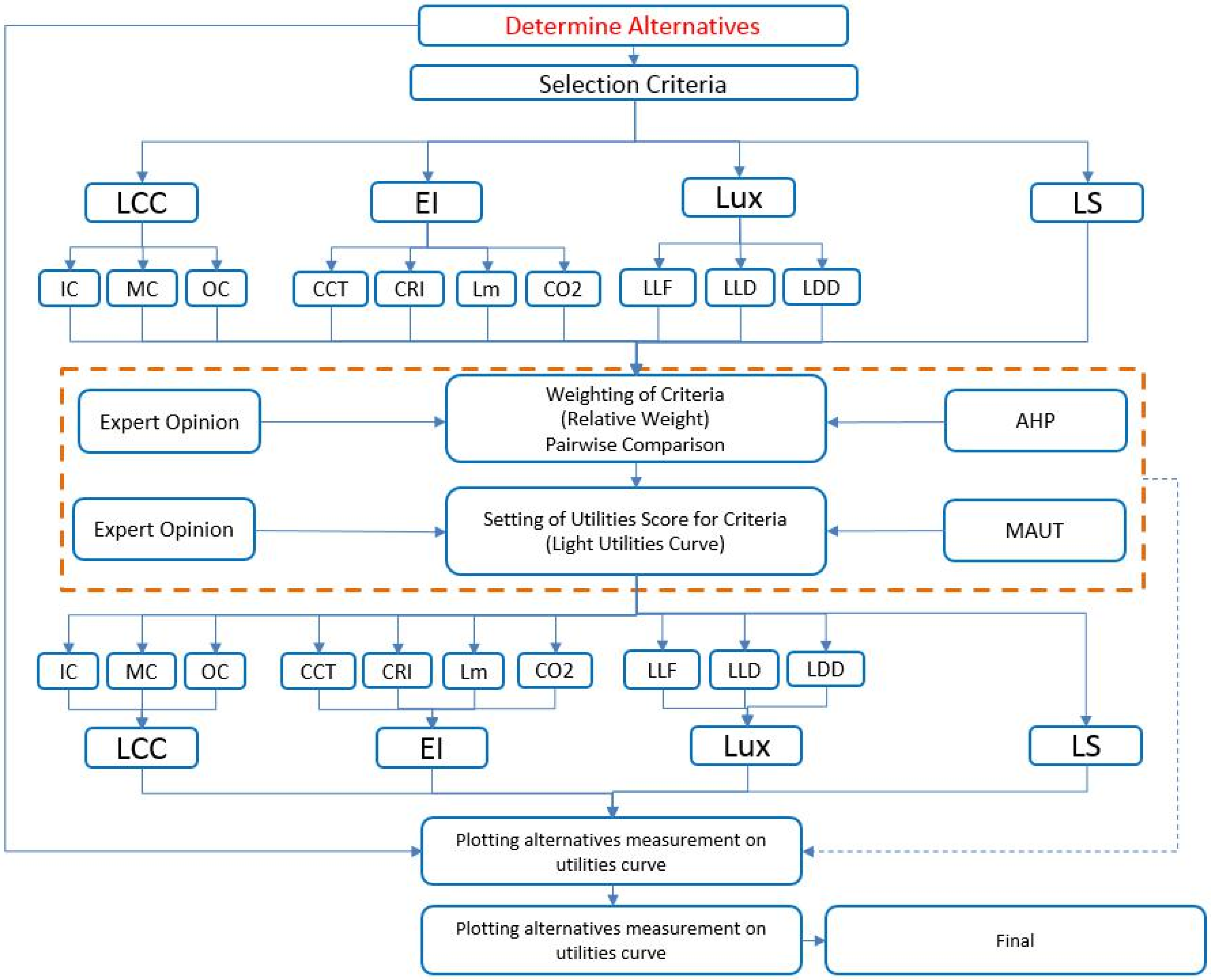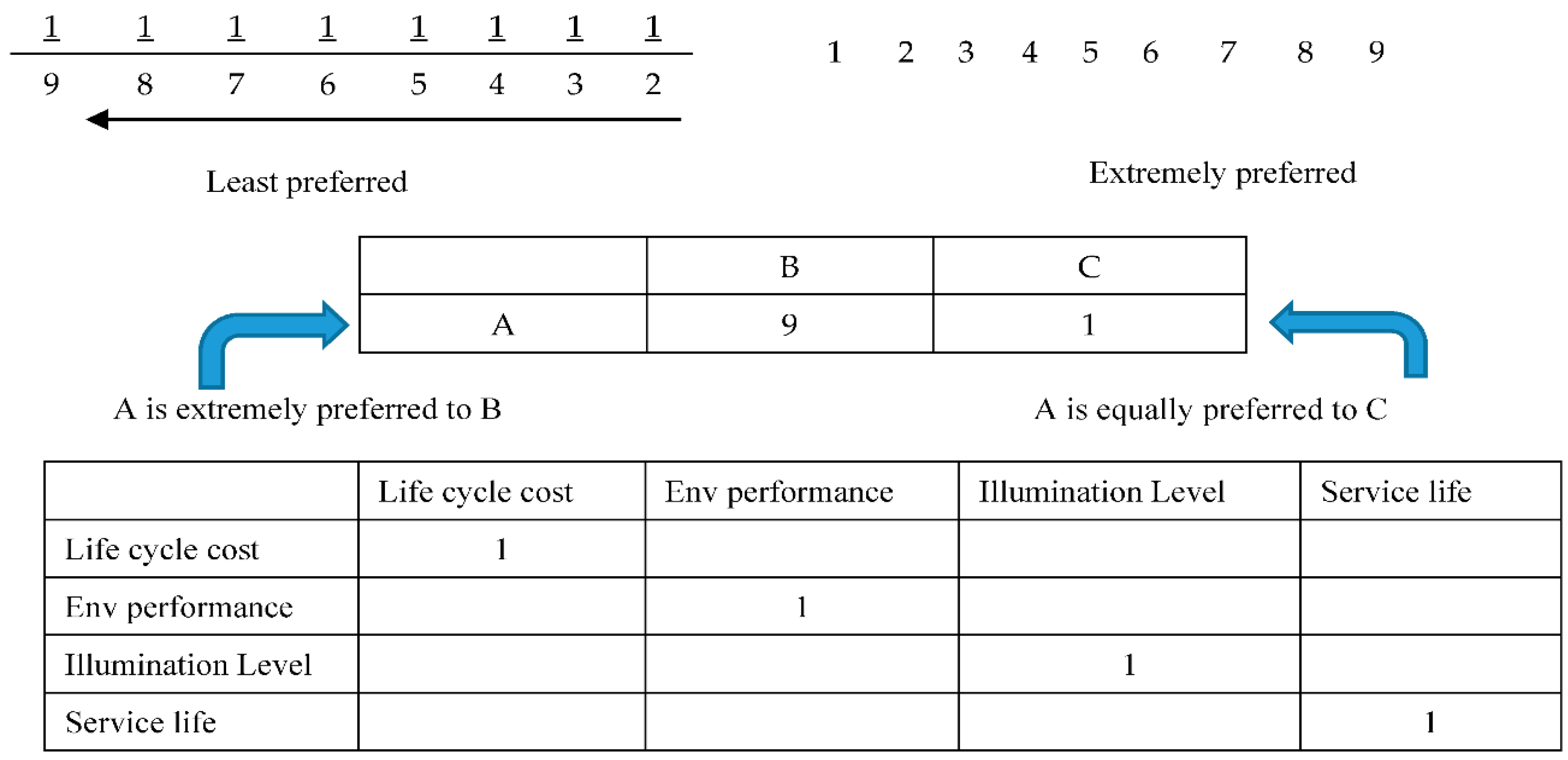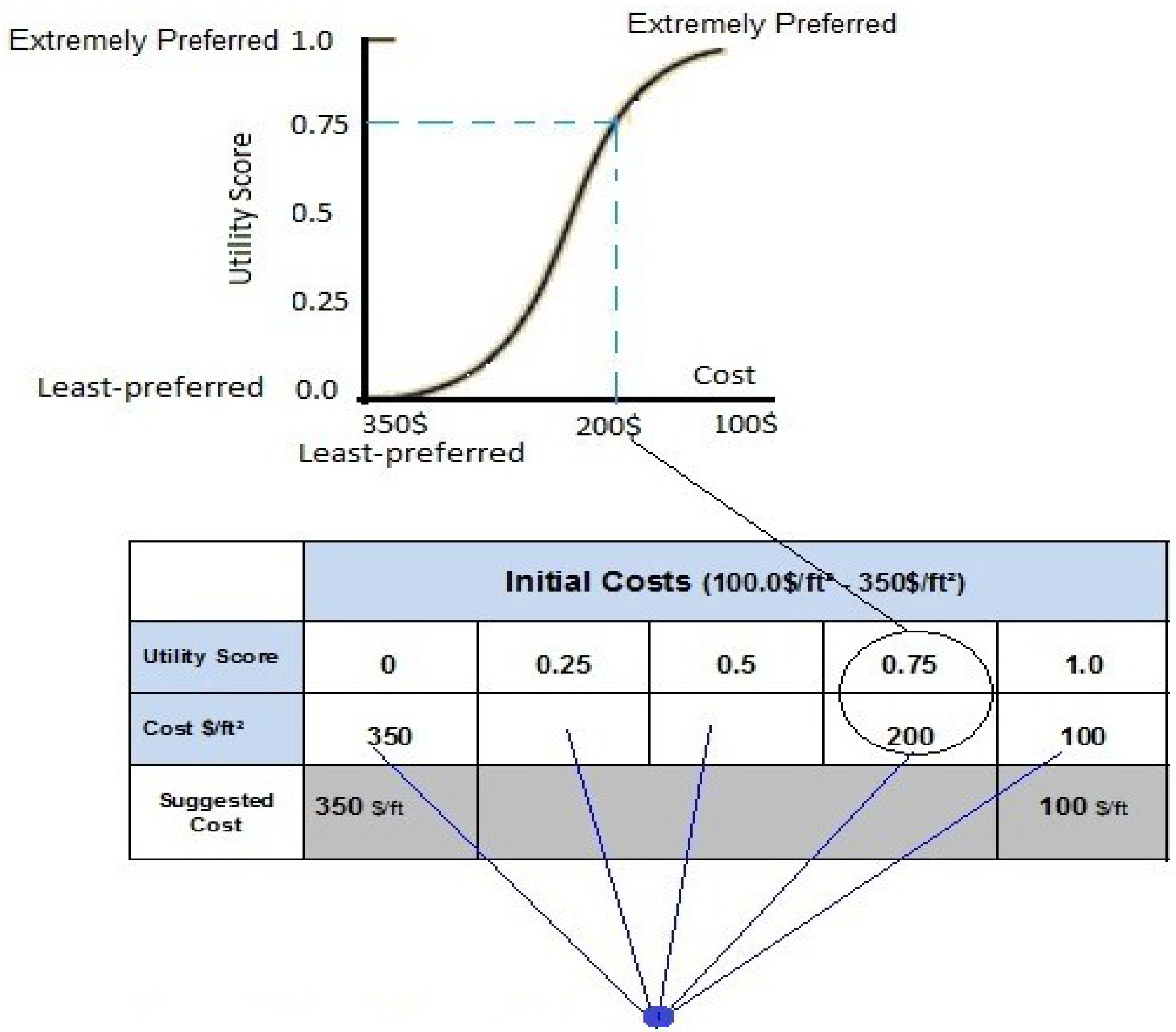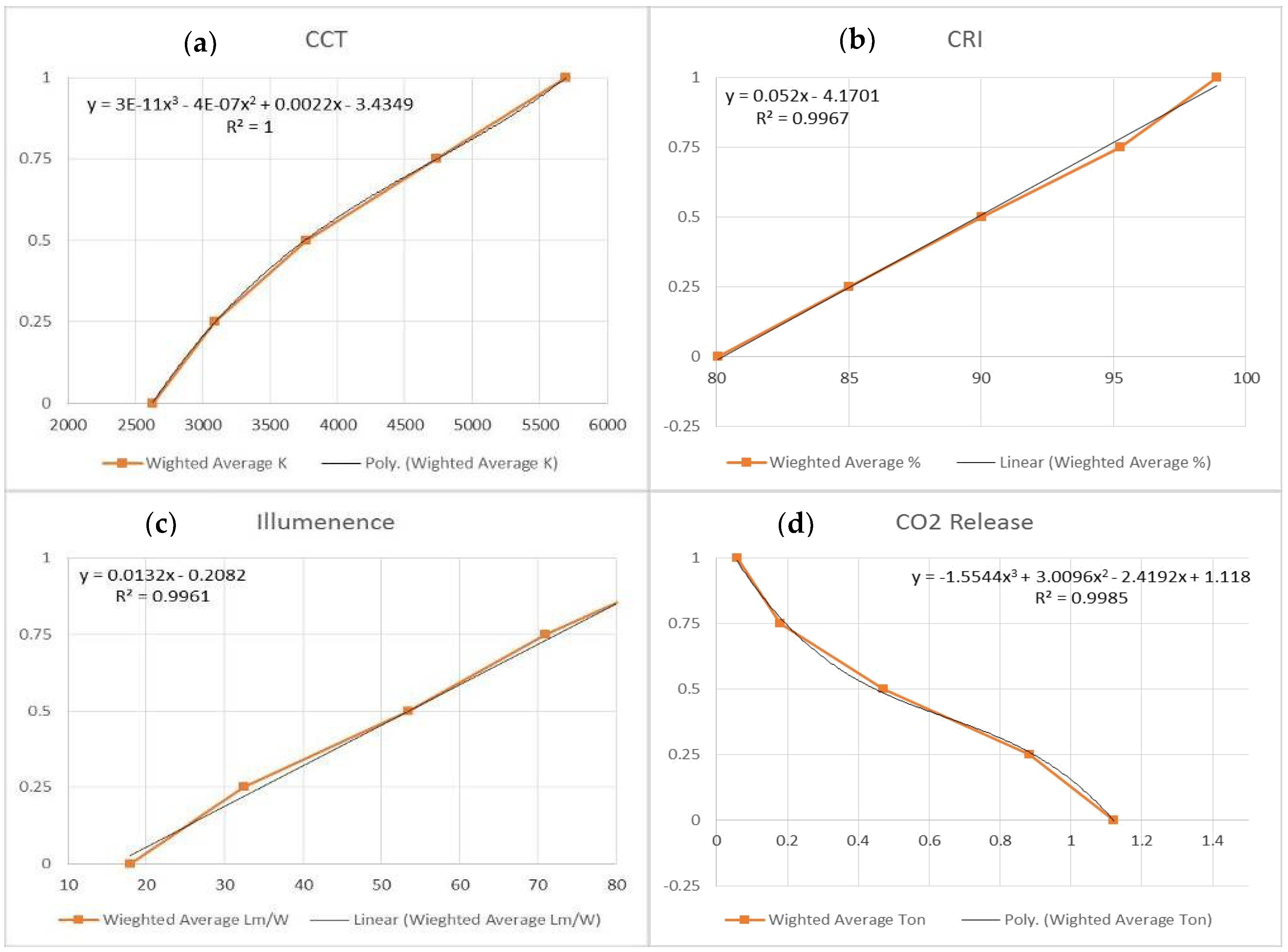1. Introduction and Objective of the Work
Lightingisoneof themost importantof allbuilding systems; it impacts the buildings occupants’ visual comfort and behavior. Also, it has a high potential for energy efficiency and emission reduction. In Saudi Arabia, lighting represents a considerable portion of electricity consumption in residential buildings [
1]. It contributes up to 50% of the total electricity consumption, and considerableCO
2 emissions [
1,
2]. In China for example, the power consumption due tolighting is estimated to account for approximately 13% of the total [
3]. Lighting fixturesarealso identified as one of the main causes of extra energy consumption [
4]. Thus, selecting an efficient lighting system design, or replacing existing one, is a crucial and a complex process for decision makers. The complexity is attributed to the consideration of multi criteria in the selection process.
In current practice, the selection process requires the involvement of a higher management level to resolve conflicts among project teams, and to make decisions based on experience rather than on scientific methodology, or on tools which may compromise the criteria and optimize the selection.
Furthermore, identifying the criteria of selection, along with the assessment of its importance, is the most important task in the selection process, andmay take long time to complete. The delay in finalizing the selection of a lighting system forongoing projects can cause cost-effective projects to waste time and money. Delays and/or cost overruns affect business portfolios, since theyleads to delays in other activities, and cause disruptions inthe projects globally.
The selection of a new lighting system, or replacing an old one, is usually carried out based on personal experience, and is therefore not subject to the needs and constraints that actually govern the selection of the best system based on the evaluation of performance against certain measures.
The literature reveals that over the years, a wide range of methods and techniques havebeen introduced to facilitate the selection process where multi criteria of selections are considered. There are several studies in the literature for selecting lighting systems in buildings. Most of these studies have focused on technical aspects of the selection, such as efficiency, safety, visual comfort, satisfaction, and energy consumption, etc. e.g., [
3,
5,
6].
Since its introduction in 1980s, AHP alone, or combined with other techniques, has beenextensively utilized to facilitate the selection process in many complex applications in the building industry. AHP divides a complicated problem into a simple and manageable hierarchy of factors [
3]. For example, in selecting lighting systems, [
7] proposed an AHP-based framework which consists of various criteria for the installation of the median barriers for national highways. The selection criteria considered in the study were regional equity, safety, efficient economy, and installation possibilities, while giving high priority to safety. Lv et al. [
3] also introduced an AHP-based evaluation system for an efficient lighting project. The system accounts for public policies combined with evaluation factors and sub factors. The considered factors were technology, equity, adequacy, economy, and environment. The system was tested in China’s energy conservation project. The results provided by the system showed that there were environmental benefits of 80% savings in energy consumption,a reduction of 10.98 billion tons of carbon emissions, and savings of up to 1.362 billion RMB.
Jin et al. [
7] conducted a field study for measuring and evaluating the quality of interior lighting in shopping centers in China. The study considered visual comfort and users’ satisfaction. The study utilized a questionnaire to investigate the differences in people’s subjective evaluations. The findings of the study can be used by the designers to come up with a design that offers the most benefits for shopping mall shoppers.
Despenica et al. [
8] looked at the problem of designing lighting systems in office buildings in different ways. The study considered the preference profiles of users by: (1) offering several choices in the same zone to avoid conflict; (2) allocating different zones among different profiles that may face conflict; and (3) measuring the tolerance and the lighting control behavior of the users.
In addition to AHP, simulation based models were also introduced in the literature to compare the use of Light-Emitting Diode (LED) and Compact Fluorescent Lamps (CFL). Energy consumption and greenhouse gas emissions from each alterative were calculated and compared, and then the best alternative was selected [
9]. It is worth noting that the outputs of simulations allow for conducting IF THEN-type analyses. This assists decision makers to review different scenarios in the selection process. Although simulation-based models have been identified for their strength in analyzing multifaceted problems, the vital limitations of applying such methods in general are: (1) simulationsaretime-consuming technique, and require the collection of considerable amounts of data that may not be available in some situations, such as those in the facilities management industry; (2) They require the input of experts to offset the lack of data availability; (3) Simulations require dedicated professionals, which may be beyond the capabilities of some decision makers; and (4) Simulations require several runs to produce reliable outcomes.
Maleetipwan-Mattsson et al. [
10] studied the factors that may affect the optimal lighting use in hospitals, and may lead to reductions in energy consumption. The study was conducted through measurements of the rooms, observations, and a questionnaire. Das et al. [
11] introduced a model for the light design for the exterior, to meet energy and consumer demands by optimizing cost, increasing robustness, and by delivering reliable and high-quality exterior lighting. An LED flood lighting system was suggested for exterior lighting to achieve efficient lumen output.
Linhart and Scartezzini [
12] carried out a comparison of two energy efficient lighting scenarios for evening lighting in offices buildings;the reference scenario had 4.5 W/m
2 of Lighting Power Density (LPD), and the test scenario, which wasmore energy efficient,had3.9 W/m
2 of LPD. The comparison was performed to extract the results of visual performance, visual comfort, and energy efficiency for evening lighting selection in office buildings. The results indicated that energy efficient lighting with 5 W/m
2LPD can be easily achievable without degrading fair visual performance and comfort, such that can be obtained withlowerconnected lighting power.
Kelly and Rosenberg [
13] conducted an intensive study onthe use of CFLs and LEDs in residential buildings in the US. Information from the past 25 years showed that CFLs faced many adoption barriers in the 1980s, due to consumer dissatisfaction and poor marketing strategies that were overcome by the US Department of Energy (DOE) and ENERGY STAR in 1999–2001. Although LEDs also faced certain market barriers in the past due to quality, cost, and functionality, soon after they gained popularity through efficient marketing strategies and DOE efforts to initiate CALiPER programs for technology advancements. The results showed that CFLs took longer to penetrate the market compared to LEDs, due to the lack of technological advancements and marketing efforts.
The main limitations of the above-described studies, individually or collectively, are that they did not adequately consider other important factors that may affect the selection process, such as life-cycle cost, light loss factor, land lumen depreciation, luminaire dirt depreciation, correlated color temperature (CCT), color rendering index (CRI), lumen (LM), and carbon dioxide (CO2) emissions. In addition, the studies did not systematically integrate the opinions of the experts in the selection process, in the absence of the numerical data.
The objective of this paper is to present a systematic approach developed for selecting lighting systems in residential buildings. The approach addresses the aforementioned limitations incurrent practices, and to be applied by decision makers specializing in this type of work.
2. Overview of the Proposed Approach
To meet the objective of this work, five principal stages were focused up, as shown in
Figure 1. The first stage requires the identification of the most widely used alternatives forlighting systems in residential buildings in Saudi Arabia. In this stage, local project managers and suppliers in the private sector were consulted to determine the alternatives. The identified alternatives considered in this study are LEDs, CFLs, Incandescents, and Halogens.
The second stage involves the identification of the main and sub-criteria that should be considered in the selection process. This stage was carried out by conducting a pilot study with several local experts, mainly project managers, architects, and contractors. The identified main and sub-criteria are:(1) Life-cycle cost criterion, including initial, maintenance, and operating costs; (2) Environmental performance criterion, including correlated color temperature (CCT), color rendering index (CRI), lumen (LM), and carbon dioxide emissions; (3) Illumination criterion, including light loss factor, and land lumen depreciation; and (4) Luminaire dirt depreciation.
The third stage comprises the evaluation of the importance of the identified criteria by experts and decision makers using the AHP technique. The evaluation of criteria at this stage was performed using the pair-wise comparison matrix method, as shown in
Figure 2. For example, the experts were asked to determine the level of importance through acomparison of the life-cycle cost criterion with all other criteria one by one, such as environmental performance, illumination level, and service life.
The fourth stage involves the development of the multi-utility theory curves, based on standards or expert opinions. For example, the Life-cycle cost criterion is divided into three sub-criteria, including initial cost, operating cost, and maintenance cost. The utility curves were built for all sub-criteria. For instance, in the initial cost criterion, the average of the best cost value was determined to be 8 Saudi Riyal (SR), while the highest average cost was 63 SR. Fifteen experts participated in developing these curves.
The incorporation of AHP and Multi Attribute Utility Theory (MAUT) occurs in the next step, in which each identified alternative measurement is plotted on all of the utility curves. In this stage, the performance of each alternative is measured over all the selected criteria. For instance, a compact florescent system has a service life of about 8000 h, and its annual operating cost is about 20.1 SR, while the LED has a service life of 25,000 h, and annual electricity costsare about 12 SR.
The final stage comprises the calculation of the total score, and the selection of the best system. The calculation of the performance of each alternative in each criterion was first measured using utility curves. The performance of each alternative was then multiplied by the importance of each criterion, as determined by AHP technique. The total score of each alternative was calculated by adding up its whole performance overall according to the selection criteria. Finally, the selection of the best alternative was done based on the highest obtained score in comparison to those of thealternatives.
2.1. Application of AHP and MAUT
Unlike with current methods, the developed approach combines AHP and MAUT to identify the significant influence of the identified main and sub-criteria in selecting lighting systems for residential buildings from a design point of view. Combining AHP and MAUT is relatively new in the selection process of complex problems e.g., [
14]. AHP and MAUT are utilized to develop the proposed approach by applying the two techniques, based on experts’ opinions, across the community services organizations in the third and fourth stages described above.
In the third stage, AHP and MAUT are used to develop the selection method by measuring the importance of the main identified criteria: Life-Cycle Costs (LCC), environmental performance, illumination and life span. The evaluation process is extended to the sub-criteria to measure the importance of each sub-criterion, and to identify their impact on the main criterion, as well as the overall criteria. Both main and sub-criterion are given a relative weight through the AHP matrix and a pairwise comparison.
In the fourth stage, utility curves are developed for the criteria using experts’ judgments, by using the overall result with simple averages for the scale. The performance of alternatives in each main and sub-criteria are plotted against the developed curves with the measured scores. Lastly, the total scores are computed for all alternatives by having the grade for each, a comparison is carried out for the alternatives, and the highest obtained score is then selected. The following section explains these stages in more detail.
2.2. AHP and Pair-Wise Comparison
To be concise in taking a decision, a pair-wise comparison is conducted for main and sub selection criteria using AHP. The comparison is executed based on experts’ opinions, with relative importance applied to all categories and sub-categories. A scale of 1/9-9 is used, as illustrated in
Figure 2. In the pair-wise comparison matrix, the experts first used the AHP decision-making technique to fill out the matrix. A quantification of relative weights is performed through this method for specific criteria set related to the priorities scale ratio of 1/9 (least preferred to most). The criteria in the first row and the first column must be compared to each other by the experts. The first matrix evaluates the main criteria, including LCC, environmental performance, illumination, and service life.
A quantification of relative weights are also performed through this method for specific criteria and its sub set, related to the priorities scale ratio of 1/9.
Table 1 shows that initial cost is muchpreferred to operating cost (9 scores), while initial cost is equally preferred to maintenance cost (1 score). Each sub-selection criterion is evaluated for each main criterion, such as life-cycle cost, which includes initial, operating, and maintenance costs.
2.3. Measuring the Performance of the Identified Alternativesusing MAUT
The Multi-Attribute Utility Technique (MAUT) is utilized to measure the performance of the identified alternatives against main and sub-criteria standardized values throughout the utility scores. This measurement is performed on the accepted responses to questionnaires, using the consistency and reliability measures. Ranking the criteria is done by measuring the weight of each criterion using pair-wise comparison and the AHP technique.
The MAUT method requires the determination of the highest and lowest value for each criterion. A utility score of 1.0 is assigned to the most-preferred value, while 0.0 is assigned to a least-preferred value. A midpoint value, which has a utility score of 0.5 is then identified by the experts. The midpoint value is a halfway value between the most- and least-preferred values [
13,
14]. After the identification of the midpoint value, ‘quarter point’ value, having a utility score of 0.25, is identified by the experts, which is a halfway value between the midpoint and least preferred values. Finally, a value function having a utility score of 0.75 is identified by the experts, which is a halfway value between most preferred and the midpoint value [
15,
16]. Once the experts determine these five values, a utility attribute or value function graph is plotted, as illustrated in
Figure 3.
5. Discussion and Selection of Alternatives
Table 12 represents the scoring of the considered alternatives and their contributions against the measurement curve, for both main and sub-criteria with values and utility scores. These values can be approached by applying themmanually, using the utility curve, or subjecting themto the derived equations of the developed curves, as presented in
Figure 6. Multiplying the values in
Table 12 by the obtained relative weights of criteria using AHPs Matrix in
Table 13 resulted in the obtained score for all alternatives, as presented in
Table 14. For example, the performance (utility value) of LED in initial cost criterion is 0.311, as presented in
Table 12, while the importance weight (relative weight) of the initial cost is 0.428, as presented in
Table 13. Multiplying the utility value (0.311) by the relative weight (0.428) is equal to 0.133, as presented in
Table 14.
Figure 7 presents the alternatives’ performance overall according to the sub-criteria. It shows that the best alternative in initial cost is Incandescent followed by Halogen, due to their low prices compared to LEDs. In contrast, LED system proved to have the best performance with the lowest maintenance and operation costs, followed by CFL.
The LED also proved to have the best performance in many sub-criteria, such as CO2emissions, light loss factor LLF, lumen land depreciation, and the overall service life.
The total score of each alternative was calculated by adding up its globalperformance overall, according to the selection criteria, using Equation (1). Finally, the selection of the best alternative is made based on the highest obtained score in comparison to the other alternatives.
Table 15 presents the total computed scores for all alternatives overall, according to the main criteria. The highest score value was recorded for the LED, followed by CFL. The LED obtains a total score of 0.66, and 0.56 for the CFL, as noted in the table. Hence, the best lighting system to be used in residential buildings according to the tested criteria is the LED system, followed by CFL.











